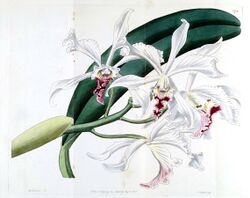Biology:Cattleya crispa
From HandWiki
Short description: Species of orchid
| Cattleya crispa | |
|---|---|

| |
| Illustration of Cattleya crispa | |
| Scientific classification | |
| Kingdom: | Plantae |
| Clade: | Tracheophytes |
| Clade: | Angiosperms |
| Clade: | Monocots |
| Order: | Asparagales |
| Family: | Orchidaceae |
| Subfamily: | Epidendroideae |
| Genus: | Cattleya |
| Subgenus: | Cattleya subg. Cattleya |
| Section: | Cattleya sect. Crispae |
| Species: | C. crispa
|
| Binomial name | |
| Cattleya crispa | |
| Synonyms[1] | |
| |
Cattleya crispa is a species of orchid indigenous to the Tijuca Mountains north of Rio de Janeiro, Brazil , noted for its crisped and ruffled petals and lip. It is the type species for both the subgenus Cattleya subg. Crispae and its section Cattleya sect. Crispae.
Prior to 2000, C. crispa had long been placed in the genus Laelia because it had eight pollinia, instead of the four found in Cattleya labiata, the type species of the genus Cattleya.[2] In 2000, the "Brazilian Laelias" (including L. crispa) were transferred to the genus Sophronitis.[3] In 2008, the entire genus Sophronitis was sunk into the genus Cattleya, and S. crispa was given its original name of C. crispa.[4]
References
- ↑ [1], World Checklist of Selected Plant Families, accessed October 14, 2010
- ↑ van den Berg, Higgins, Dressler, Whitten, Arenas, Culham, and Chase: "A Phylogenetic Analysis of Laeliinae (Orchindaceae) Based on Sequence Data from Internal Transcribed Spacers (ITS) of Nuclear Ribosomal DNA", Lindleyana 15(2): 96-114. 2000. The American Orchid Society.
- ↑ van den Berg, C. and M. W. Chase. 2000. "Nomenclatural notes on Laeliinae—I." Lindleyana 15: 115-119
- ↑ C. van den Berg "New Combinations in the Genus Cattleya Lindl. (Orchidaceae)" Neodiversity 3 (2008) 3-12.
External links
- Orchids of Brazil listing - mirandaorchids.com (includes pictures of C. crispa and distribution map)
Wikidata ☰ Q6470922 entry
 |

